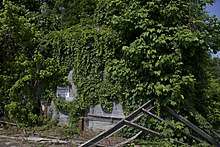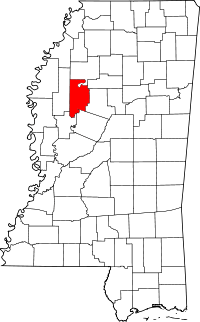Money, Mississippi
| Money, Mississippi | |
|---|---|
| Unincorporated community | |
|
Leflore County Volunteer Fire Department in Money | |
 Money, Mississippi Location within the state of Mississippi | |
| Coordinates: 33°39′04″N 90°12′33″W / 33.65111°N 90.20917°WCoordinates: 33°39′04″N 90°12′33″W / 33.65111°N 90.20917°W | |
| Country | United States |
| State | Mississippi |
| County | Leflore |
| Elevation | 138 ft (42 m) |
| Time zone | UTC-6 (Central (CST)) |
| • Summer (DST) | UTC-5 (CDT) |
| GNIS feature ID | 673728[1] |
Money is an unincorporated Mississippi Delta community in Leflore County, Mississippi, United States near Greenwood.[2] It has a population of less than 100, down from 400 in the early 1950s when a cotton mill operated in the community. It is on a railroad line and located along the Tallahatchie River, a tributary of the Yazoo River in the eastern part of the Mississippi Delta. Money is part of the Greenwood, Mississippi micropolitan area and has the ZIP code 38945.
It is notable as the site of the 1955 lynching of 14-year-old Emmett Till by white men, an event that gained nationwide attention. The suspects were acquitted by an all-white jury in 1955. They sold their story to Look magazine the next year and admitted their role in a 1956 interview.
History
This rural area was developed for cotton cultivation. A post office called Money was established in 1901.[3] The community was named for Hernando Money, a United States Senator from Mississippi.[4]
Murder of Emmett Till

Money became infamous as a result of the lynching of Emmett Till, a 14-year-old African-American boy from Chicago, who was visiting his uncle Moses Wright in August 1955. Till was accused of flirting with Carolyn Bryant, a white woman working alone at Bryant's Grocery, a store which she owned with her husband Roy Bryant. In 2007 Bryant revealed that she had fabricated details of the encounter that she testified to.[6]
After the encounter, Roy Bryant and his half-brother, J.W. Milam, abducted, tortured and murdered Till because of the rumor that he had flirted with Bryant's wife, crossing the "color line". The pair were arrested and tried for the murder, but were acquitted by an all-white jury. Several months later, they sold their story, and confessed to the killing in an interview with William Bradford Huie that was published in the January 1956 issue of Look magazine.
Till's mother, Mamie Till Bradley, insisted on an open casket funeral for her son in Chicago. She wanted people to see what had been done to her son, who had been badly beaten before his death. She allowed news photographs of his body to be published. National awareness was heightened of lynching in the South and the oppression and violence against blacks under Jim Crow. Many Southern historians suggest that the Emmett Till murder sparked a level of outrage that helped galvanize the civil rights movement of the 1960s, by drawing national attention to injustices in the South.
In popular culture
A wooden bridge crossing the Tallahatchie River at Money was referred to in Bobbie Gentry's 1967 hit song "Ode to Billie Joe." The November 10, 1967 issue of Life contained a photo of Gentry crossing the bridge. That bridge collapsed in June 1972 after being burned by vandals.[7] It has since been replaced.
Notable people
- James Schaffer – religious leader and centenarian.
- Willye White – Olympic athlete.[8]
Gallery
- Former Money post office
 Mississippi Freedom Trail Marker
Mississippi Freedom Trail Marker
References
- ↑ "Money". Geographic Names Information System. United States Geological Survey.
- ↑ "Money, Mississippi". Geographic Names Information System. United States Geological Survey.
- ↑ "Leflore County". Jim Forte Postal History. Retrieved 1 November 2015.
- ↑ Gallant, Frank K. (16 February 2012). A Place Called Peculiar: Stories about Unusual American Place-Names. Courier Corporation. p. 95. ISBN 978-0-486-48360-3.
- ↑ "Emmett Till's Legacy 50 Years Later." Jet. Johnson Publishing Company. September 19, 2005. Vol. 108, No. 12. ISSN 0021-5996. Retrieved from Google Books on July 4, 2010.
- ↑ "Woman Linked to 1955 Emmett Till Murder Tells Historian Her Claims Were False". Retrieved 2018-08-07.
- ↑ Tobler, John (1992). NME Rock 'N' Roll Years (1st ed.). London: Reed International Books Ltd. p. 239. CN 5585.
- ↑ Wiggins, David K. (26 March 2015). African Americans in Sports. Routledge. p. 401. ISBN 978-1-317-47744-0.
